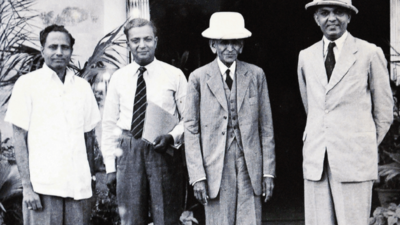ARTICLE AD BOX

Sir M Visvesvaraya (second from right) with the doyen of Indian aviation, Dr VM Ghatage, (second from left) at HAL
The changing world of work is leading to higher fiscal spending by govts, hiring hesitations by companies, and job anxiety for individuals. Some forces affect the whole world, while others are more specific to geographies.
However, Bengaluru represents the future of work in India; anyone can get a job within a week due to a constantly changing, growing, diversifying, and innovating labour market that nurtures high productivity sectors, firms and individuals. Five forces are affecting the global world of work. First, employment has moved from a lifetime contract to a taxicab relationship -- short and intense.
Second, the life expectancy of companies has moved in the opposite direction of humans; it has declined for Fortune 500 companies from 64 years in 1950 to 15 years today. Third, college isn’t what it used to be because the world has produced more graduates in the last 40 years than the 800 years before that. Consequently, college graduates make up 60% of taxi drivers in Korea, 31% of Walmart retail check-out clerks in the US, and 15% of high-end security guards in India. Fourth, cognitive professions have higher inequality than physical professions due to productivity. A good plumber, electrician, or salesperson is five times better than a bad one, but a good software programmer is a hundred times better, a good investor is two hundred times better, and a good CEO is five hundred times better than a bad one.
Finally, the rise in global self employment is not an increase in the entrepreneurial gene, but rather because the poor cannot afford to be unemployed. Most self-employment is self-exploitation, where workers earn enough money to live, but not enough to escape poverty. All five forces affect wages more than jobs. Bengaluru’s world of work operates within the broader context of India’s and Karnataka’s economic development.
Both have no shortage of the traditional factors of production -- land, labour, and capital -- but face challenges in how these three combine. Economists call this combination Total Factor Productivity, while human beings describe it as entrepreneurship, technology, or innovation. Harvard economist Ricardo Hausman describes development as a game of Scrabble: the govt provides the vowels, while the private sector offers the consonants, and progress lies in making longer and more words. Bengaluru defies India and Karnataka’s labour market because it has more vowels and consonants that come from being diversified, meritocratic, and innovative. Its job market is highly diversified -- manufacturing and services, big and small firms, venture capital and debt-funded firms, domestic and multinational firms, North and South clusters, and much more. It has the highest concentration of social security payers, venture capital investment and engineering college seats per capita among all Indian cities.
It is highly meritocratic; the nature of companies, entrepreneurs, and industries means that the courage in your heart, sweat on your brow and strength of your back matter more than your surname. Finally, it is highly innovative in generating new ideas; new recipes instead of more cooks in the kitchen because of early engineering deregulation and a consistent tone from the top on human capital, starting with Visvesvaraya and Mirza Ismail, but continued by chief ministers. Building a thriving city like Bengaluru is not the solving of a sum, but the painting of a picture over generations. Given the high level of firm and individual productivity, if everyone in India lived in Bengaluru, India’s GDP would be higher than China’s. Why? Because it was the first electrified city of India and the first in Asia to have streetlights? Because it is an education cluster? Because of the weather? Because a German planted trees? Because Mirza Ismail made a venture capital investment in Walchand Aerospace, which became HAL? Because it is located at the intersection of three state borders? Because it is the city where its people speak 107 languages? Because it aggressively deregulated engineering college education? Because it is one of the few Indian cities where rental yields equal borrowing rates? Or is it because Texas Instruments, IBM, Infosys and Wipro chose it to start, and decades later, this opening balance created Global Capability Centres? It’s impossible to know whether supply (people and skills) or demand (jobs and firms) or their combination (entrepreneurship and policy) matters more for becoming a job cluster, but we know it’s a delicate dance between all three that Bengaluru has mastered. The title of this article comes from the Aitreya Upanishad, which reminds us that movement is everything. It is also my favourite response to every out-of-town visitor to Bengaluru who cribs about our traffic. This traffic -- 1.2 crore registered vehicles -- arises because Bengaluru is a job cluster that delivers prosperity by growing its real wages much faster than nominal wages. May Patna, Kanpur, Jammu, Bhopal and Chennai be blessed with this problem. This doesn’t deny that Bengaluru has work to do. However, my faith lies in Bengaluru’s unfair advantage: the widespread adoption by the city’s residents of the meaning of ‘Charaiveti’. Keep moving, persevering and learning.



.png)
.png)
.png)
















 4 hours ago
3
4 hours ago
3









 English (US) ·
English (US) ·